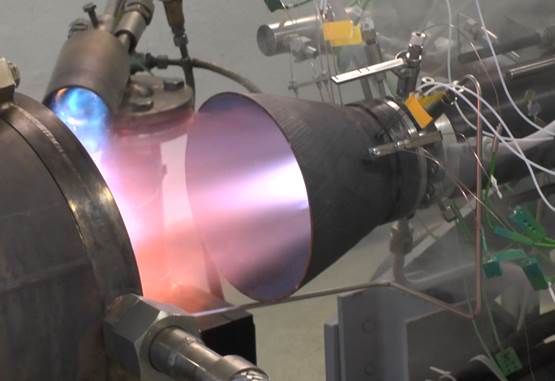Transpiration Cooled Ceramic High Performance Rocket Engines
Motivation and Design
- Improvement of high performance rocket engines
- Use of high temperature resistant and porous Ceramic Matrix Composites (CMC)
- High operation efficiency combined with transpiration cooling
- High operational reliability and damage tolerance
- Adaptation potential focussing several propulsion system cycles
- Light weight at high strength combined with CFRP housing
- Low fatigue caused by low thermal expansion structures
- Innovation potential for porous injection
- Optimization of the supersonic nozzle interface
- CMC/CFRP subsonic combustion chamber
- CMC injector: new design technology
- CMC supersonic nozzle extension.
Operational Requirements and Technological Approach
- Optimization of the supersonic nozzle interface
- Suitable material selections and coolant mass flow ratio‘s
- High temperature and thermochemical resistance at inner liner
- Natural micro-porosity of CMCs for coolant diffusion
- Adjustable coolant-permeability at CMCs
- Homogeneous coolant out-blow at inner surface
- Easy structural design and manufacturing
- Use of miscellaneous CMC properties at inner liner
- Thermochemical adaptation – stacking of mixed materials
- Diffusion adaptation – porosity defined by production process
- CMC densities: 2 – 3 g/cm3
- CFRP load shell – CTE » 6 × 10-6 1/K; densities 1.3 – 1.8 g/cm3
- Highly de-coupled structure principle; innovative interface technologies
- High degree of thermomechanical compatibility
- Established material quality management and reproducibility
- Spray optimization at porous injection
- Multi-shell design of the supersonic CMC nozzle extension.
Technology Demonstration and Outlook
- Thermochemical resistant CMCs damage free operated
- High resilient CFRP-metal-interface proven & Cryogenic sealing technology reliable
- Extensive efforts on analytical and experimental basics
- Multiple high performance tests at
- European Research and Technology Test Facility P8
- Technology Test Bench P6.1
- TRL (Technology Readiness Level) of transpiration cooling: 5
- First promising P6.1 hot runs of the new injector concept
- First P6.1 proof tests of the partial double-shell nozzle design
- Full-scale 60 kN LOX/Methane demonstration at TRL 5
- Industry transfer / Licencing.
German Aerospace Center (DLR)
Institute of Structures and Design
Markus Ortelt · E-Mail: markus.ortelt@dlr.de · DLR.de
